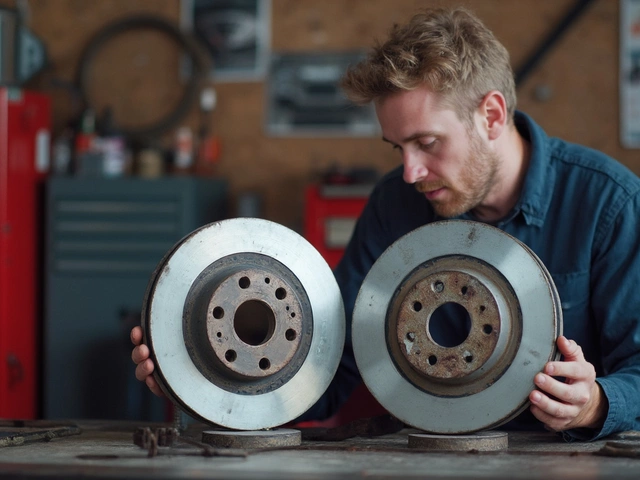Living life in the fast lane often means we forget to check in on the hardworking machinery that keeps us on the road. Your car's engine oil is one of those essential fluids that don't ask for much attention, but give so much in return. Without enough oil, your engine might start crying out in ways you'd rather it didn’t.
While we navigate through daily routines, our cars serve as the silent workhorses, yet they whisper signals when they're running dry. If you’ve ever noticed unexplained sounds or blinking lights on your dashboard, this might be a timely reminder to check your oil levels. Recognizing these signs can seem like car telepathy, but with a little guidance, it’s more straightforward than it seems.
Imagine your car's engine as an entire orchestra, where oil plays the role of the conductor, keeping everything in harmony. Without it, the misaligned symphony can lead to costly damages—or at the very least, a disrupted day. So, let’s delve into the key signs indicating it might be time to add some life-lubricating oil to your engine.
- Understanding Engine Oil's Role
- Warning Lights and Dashboard Signals
- Unusual Noises from the Engine
- Spotting Oil Leaks
- Monitoring Oil Levels and Regular Maintenance
Understanding Engine Oil's Role
Engine oil is the lifeblood of your car—circulating, filtering, and cooling the heart of your vehicle. Without it, the machine that drives your daily commute or epic road trip would seize up and stop. Imagine if the human body ran without blood; neither would fare well. Engine oil is the actor behind the scenes, quietly lubricating the moving parts of your engine and preventing friction and wear and tear. It's specially formulated to withstand high temperatures, which is essential because engines run hot. It's tasked with carrying away heat as it flows through countless passages, ensuring components don’t overheat and break down.
The oil also cleans as it lubricates, carrying away dirt and particles to the oil filter, where impurities are trapped and held. This is as critical as its cooling role because any debris left in the system can scratch and damage parts. Over time, the oil itself can break down and lose its efficacy. That's why the timing of oil changes is not just based on a routine; it’s a science. Each type of oil—be it conventional, synthetic, or a blend—has its own lifespan, often defined by mileage or time.
The type you choose can influence your car's performance and longevity, which is why understanding what flows through your engine is beneficial for every car owner. As the oil degrades over time, it becomes less capable of performing these crucial roles. This is precisely why it's important to heed manufacturer recommendations regarding oil changes. They aren't just profit-motivated; they understand the fine workings of your engine. As a wise mechanic once said,
"Regular oil changes can significantly impact your vehicle's longevity and performance," showing the truth in prioritizing your car's lubricant needs.
Another key function of engine oil involves its role in preventing corrosion and rust. Modern oils contain additives designed to neutralize acids that form in the engine as byproducts of combustion. This is no small feat, as corrosion can devastate metal parts if left unchecked. Understanding these functions ensures you make informed choices when selecting products for your vehicle. Enthusiasts sometimes overlook the importance of oil due to its unseen nature, but anyone familiar with car maintenance software will emphasize how vital it is to consider the lifecycle of your oil and its protective qualities. When in doubt, consulting with trusted automotive professionals or materials can provide the clarity drivers need.
Warning Lights and Dashboard Signals
Your car's dashboard is like a canvas, intricately painted with indicators and symbols, each carrying their own message. Among them, the oil warning light holds particular significance. It's usually represented as an ancient-looking genie's lamp, which oddly enough, holds the key to your engine's well-being. When this light illuminates, it warns you that your engine oil levels may be low, or perhaps not circulating smoothly. Ignoring this light is tantamount to dismissing a red flag from a concerned friend. With engines becoming more complex, the significance of these lights has grown deeply intertwined with modern-day car maintenance.
Imagine driving down a highway, music playing, when suddenly, a little amber or red lamp disrupts your outback harmony. This warning directs you to check the oil level as soon as safe. Although the dashboard lights are just a few millimeters in size, their message can save thousands of dollars in repairs. A particularly well-functioning oil pressure sensor is vital, as it's directly tied to this warning light. Keeping tabs on it isn’t just for peace of mind but essential to extend the lifespan of your engine.
When discussing warning lights, it's crucial to understand what the oil pressure warning light precisely indicates. It doesn’t automatically mean low oil levels; it could also hint at oil pump failures or clogged oil passages. According to automotive expert Leon Staff,
"Ignoring the oil light is like playing Russian roulette with your engine – sooner or later, you will run into trouble."He suggests that regular oil checks can prevent 60% of engine failures attributed to oil mismanagement. Adhering to this, many newer vehicle models have begun adopting advanced oil monitoring systems that even tell you when the oil itself is degraded enough to warrant a change.
Some vehicles are equipped with an oil temperature light. While not as common, it's another critical indicator to keep an eye on. High oil temperature might indicate an inefficient cooling system or excessive strain on the engine. A gliding ride could fast turn into a strenuous slog, overheating not just the vehicle, but your patience as well. For those in colder climates or driving older vehicles, the oil pressure sensor might give faulty readings, thus necessitating a manual check. Whether modern or vintage, understanding your specific car's dashboard nuances is absolutely necessary.
Don't let the silent glow light your path to expensive repairs. Knowledge is power—but so is preventative action. Integrate regular dashboard monitoring into your routine, just like checking mirrors before merging lanes. If there’s anything drivers should hold dear in this digital age, it's the ability to read your car maintenance signals before they turn into woes. Looking at data from a recent study, nearly 25% of drivers ignore dashboard signals until their annual service, and this must change for the sake of our beloved four-wheeled companions. By translating these symbols into understandable alerts, we ensure a smoother, sustainable journey where our vehicles remain faithful partners on the road.

Unusual Noises from the Engine
As drivers, there is a symphony of sounds we're accustomed to when firing up our cars and hitting the road. Yet, when one of those notes seems off, it’s time to pay closer attention. An engine that's begging for engine oil might not remain silent about its needs. Unexplained sounds such as ticking, knocking, or clattering often herald problems with oil levels. But what exactly do these noises mean? Imagine you're revving up and hear a ticking sound that seems to match the engine's rhythm. This is usually an indication that metal parts are coming into unwanted contact because of inadequate lubrication from the engine oil.
Think of engine oil as the worthy protector that cushions parts like the lifters and pistons. Without it, components can grind against each other, sometimes producing noises that get quicker and louder as you accelerate. You might even encounter a knocking noise, often associated with worn-out bearings due to insufficient lubrication. Left unchecked, these unusual noises can escalate from bothersome to damaging, leading to considerable wear and tear on your beloved vehicle. It’s much like the human body, where neglected joints eventually lead to creaking and discomfort with movement.
We aren't alone in underestimating these seemingly minor sounds. Experts often emphasize the importance of quick attention. As popular mechanic and radio personality Tom Magliozzi once put it,
"Ignoring car sounds is like hitting the snooze button on a fire alarm."This means a vigilant ear can prevent many major headaches later on. Investing in understanding and interpreting these sounds can make a world of difference in vehicle care.
Have you ever thought about the frequency of checking your car for maintenance? In a survey conducted by the American Automobile Association (AAA), it was highlighted that vehicle neglect, often starting with something as simple as oil change laziness, leads to issues that could be easily circumvented. While noises are sometimes due to other mechanical issues, keeping engine oil in check is a preventive measure. Knowing when these auditory warnings are pointing directly at an oil issue is crucial. To avoid delays and further damage, consider visiting a trusted mechanic if you encounter persistent and mysterious sounds.
Spotting Oil Leaks
One of the most telltale signs that your car might be running low on engine oil is the presence of oil leaks. These are often more obvious than other symptoms and can be detected with a simple glance at your usual parking spot. If you've noticed dark brown or amber puddles forming under your vehicle, it's quite likely your car is leaking oil. This could happen for a variety of reasons, such as a degraded oil gasket or a worn-out oil seal, which are parts that deal with a lot of wear and tear over time, especially if they're not routinely checked.
Oil leaks can be deceptive in nature because while they might appear as minor drips, they can lead to significant oil loss over time, putting your engine at risk. It's not just about keeping your driveway clean. An unchecked leak can allow debris and dirt to mix with your oil, leading to engine sludge that can seriously affect your vehicle's performance. Additionally, a leaking oil pan or crankcase can eventually lead to larger mechanical issues, costing much more in repairs than if addressed early on.
Regularly inspect the parking spot under your car for signs of leaks. Another thing to keep an eye on is your oil level indicator on the dashboard. Frequent dips in oil levels without any visible leaks could mean the leak is internal, potentially caused by a blown head gasket or another internal issue. These should be assessed by a professional mechanic as soon as possible. For most cars, an indicator on the dash will alert you to low oil pressure, which can occur due to major leaks.
The process of identifying leaks doesn't just stop with spotting puddles. Pay attention to your car's exhaust. If you notice blue-tinted smoke, it might signify burning oil, which is often the result of worn piston rings or valve seals. It is essential to act swiftly in such situations, as ignoring these signs could significantly impact your car's performance and longevity. A wise mechanic once said, "Ignoring a small oil leak is like ignoring a ticking time bomb. It only gets worse from there."
Lastly, consistent vehicle maintenance can help prevent and spot oil leaks before they become severe. Employing the use of additives can sometimes help with minor leak prevention, but it's crucial to understand their limitations and not to rely on them for long-term solutions. Keeping a vigilant eye on these signs and seeking professional help when needed can ensure your car remains in optimal condition over time.

Monitoring Oil Levels and Regular Maintenance
To keep your vehicle's engine running at its best, keeping an eye on the engine oil isn't just a suggestion—it's a necessity. It might seem like just another chore on the long list of things in life, but regular monitoring helps you avoid the much larger inconvenience of engine trouble. The good news? It’s not as complicated as it might sound. Starting with the most basic task, make it a habit to check the oil dipstick. This small piece of metal holds the key to understanding whether your car is in need of more oil or if everything is in well-working order.
Here's a straightforward method: when your engine is cool, typically in the morning, pull out that dipstick, wipe it clean with a rag, then dip it back fully into its tube and pull it out again. You're looking for the line indicating the oil level is between the two marks or holes on the stick. If it’s low, it’s time to add some oil. But don't just top it off with any variety from the auto parts store. Consult your car manual to find the right type and weight of oil your car needs. This simple task prevents many potential problems and that's why it's a worthy part of your routine.
Did you know that regular maintenance extends beyond just checking the oil levels? It involves periodic changes and also keeping an eye on the oil's condition. Dirty oil can be as harmful as low oil because particles and contaminants can wear out engine components. Changing the oil every 3,000 to 5,000 miles used to be the golden rule, but modern advances in car technology mean most vehicles today can stretch that out to 7,500 or even 10,000 miles. Nevertheless, this depends significantly on your driving habits and specific vehicle guidelines. It's always best to refer to the manual or consult with a trusted mechanic.
In practice, keeping a car’s engine oil in form involves more than just looking at the dipstick. Watching for signs like unusual engine sounds or overheating can give you additional hints that something's amiss under the hood. And when you make use of car maintenance logs, you give yourself a reference point for when you last checked the oil and filters. A study from the Car Care Council found that the top three neglected maintenance items are oil changes, oil filter replacements, and air filters. Keeping a checklist can make it easier to remember what's due and when.
Consider what Bob Sikorsky once said about car care,
"The best way to get a balanced view of car maintenance is to consider it as an investment rather than an expense."It highlights the importance of making maintenance part of your routine. Planning regular checks means your vehicle's engine stays lubricated and runs smoothly—much like scheduling routine check-ups before small issues become bigger, more expensive problems. With proper automotive care, not only could you save money on future repairs, but you'll also improve the longevity of your car's engine.






